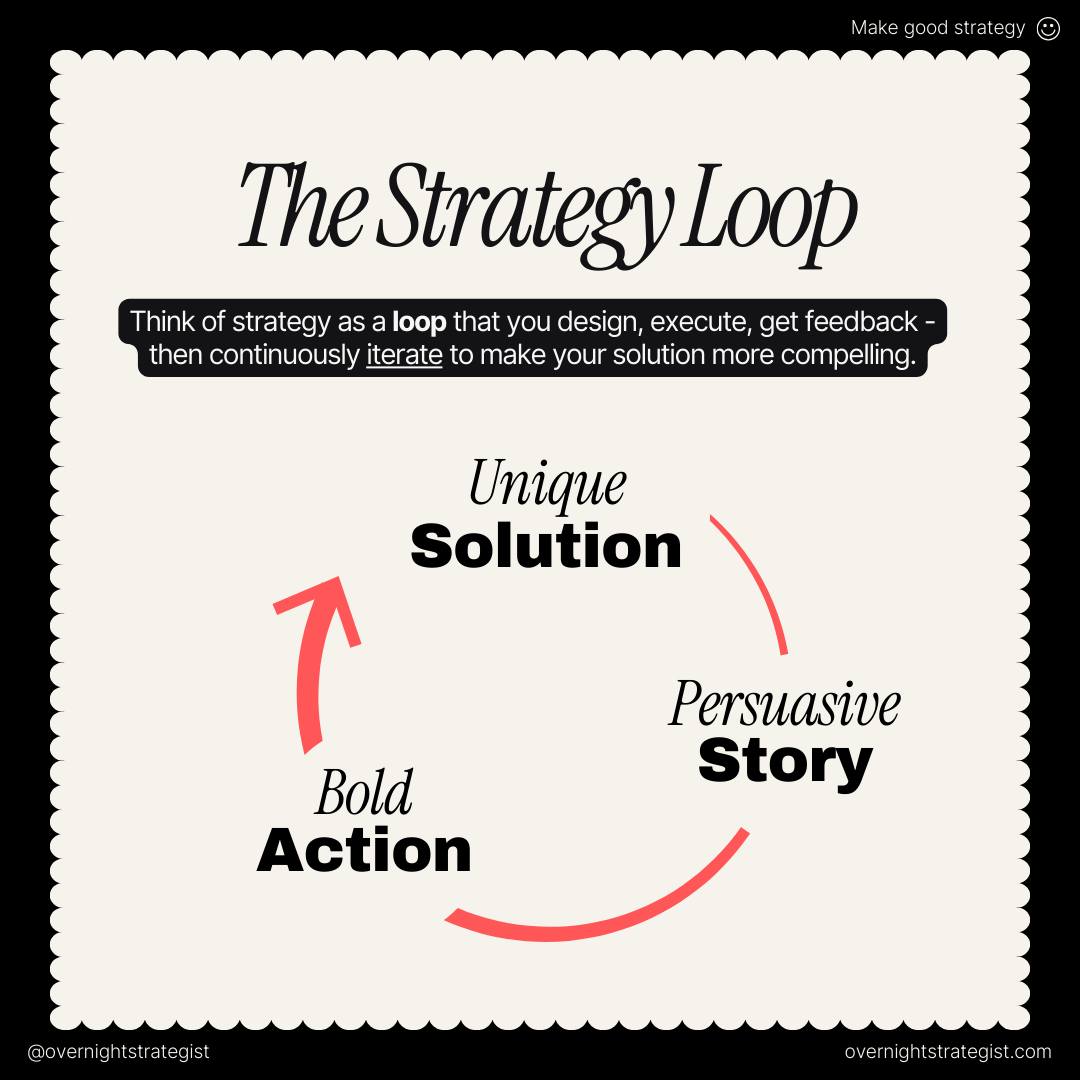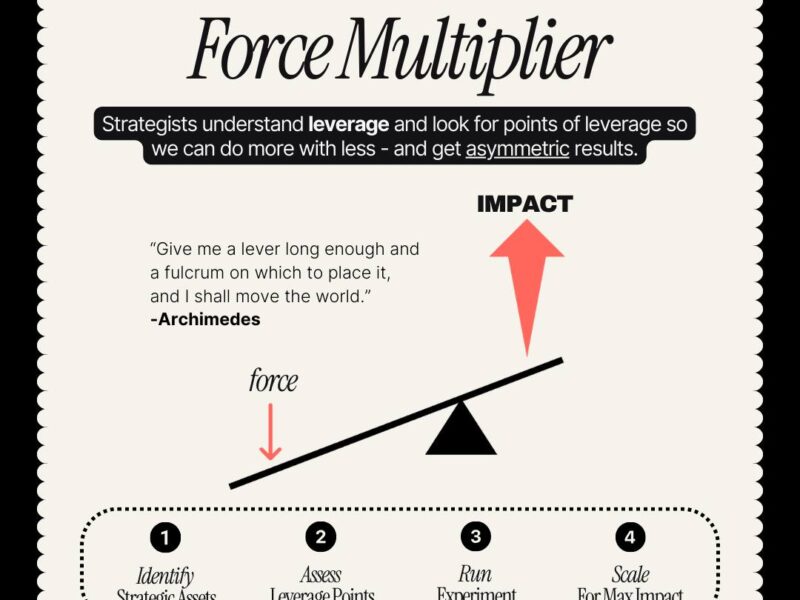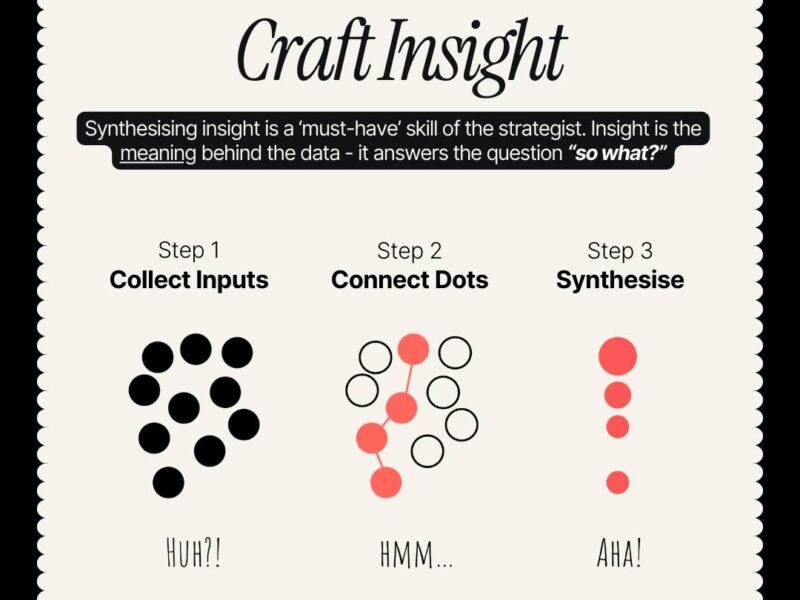Moving from Static Plans to Dynamic, Winning Systems
For decades, we’ve been sold a lie about strategy. We’re told it’s a destination—a beautifully crafted, multi-year plan documented in a PDF that gathers digital dust. We spend months in boardrooms, whiteboards filled with SWOT analyses, culminating in a “final” strategic document. Then, we execute, often blindly, only to find the market has shifted, customer needs have evolved, and our “perfect” plan is now obsolete.
As a UX designer and solutions architect with over twenty years in the trenches, I’ve learned that this static view of strategy is not just ineffective; it’s dangerous. It creates rigid organizations that break when faced with change, rather than agile ones that bend and adapt.
The truth is, strategy isn’t a straight line; it’s a loop.
It’s a continuous, living process of learning and adaptation. It’s a system you build, not a sermon you preach. This system, which I call the Strategy Loop, is the core differentiator between companies that react to the market and those that shape it.
The Strategy Loop, as visualized in the excellent graphic by Juan Fernando Pacheco, is an elegant model comprising three core, interconnected phases that feed into each other:
Unique Solution: The “What” – Crafting a differentiated value proposition.
Persuasive Story: The “Why” – Communicating that value to inspire action.
Bold Action: The “How” – Executing with intention and rigor.
And then, crucially, you Iterate, using feedback to refine all three elements continuously. Let’s dissect this loop, layer by layer, and equip you with the tools, frameworks, and mindset to implement it.
1: The Unique Solution – Beyond Problem-Solving to Value Creation
The genesis of any winning strategy is a solution that matters. But in a crowded marketplace, solving a problem isn’t enough. You must solve it in a way that is meaningfully different and delivers undeniable value.
The Core Principle: From Features to Value Proposition
A common mistake, especially in tech, is to conflate “features” with a “unique solution.” A list of functionalities is not a strategy. A unique solution is a cohesive system that addresses a core user need in a way that competitors do not or cannot. It’s about the value you create, not the things you build.
Inputs: Market research, user interviews, competitive analysis, technical feasibility studies, business model canvases.
Outputs: A clearly defined Value Proposition Statement, a Product Requirements Document (PRD), user personas, journey maps, and a Minimum Viable Product (MVP) definition.
Frameworks & Tools:
Value Proposition Canvas (Strategyzer): This is a foundational tool. It forces you to map your product’s features and services (gain creators, pain relievers) directly to the customer’s jobs, pains, and gains. The goal is to achieve a perfect fit. https://www.strategyzer.com/canvas/value-proposition-canvas
Jobs-to-be-Done (JTBD): Instead of focusing on user demographics, JTBD theory posits that customers “hire” products to get a specific job done. Understanding the core functional, social, and emotional “jobs” allows you to innovate around the real progress a user is trying to make. The classic “milkshake case study” by Clay Christensen is a masterclass in this. https://christenseninstitute.org/jobs-to-be-done/
Blue Ocean Strategy: This framework encourages you to create new market space (“Blue Oceans”) rather than competing in overcrowded industries (“Red Oceans”). By using the Four Actions Framework (Eliminate, Reduce, Raise, Create), you can break the value-cost trade-off and create a leap in value. https://www.blueoceanstrategy.com/tools/four-actions-framework/
The Architect’s Deep Dive: Systems Thinking
As a solutions architect, I view the “Unique Solution” not as a monolith, but as a system of interconnected components. When designing this system, you must consider:
Scalability: Can the architecture handle 10x, 100x the load? (e.g., using microservices, serverless functions like AWS Lambda).
Reliability: What are the SLAs (Service Level Agreements)? How is fault-tolerance achieved? (e.g., using redundant systems, circuit breakers).
Security: How is data protected? How are authentication and authorization handled? (e.g., OAuth 2.0, Zero-Trust models).
Maintainability: Is the code clean? Is the documentation good? Can new features be added without causing regressions?
A solution is only “unique” and “compelling” if it is not only functionally different but also technically superior in its delivery—fast, secure, and reliable.
2: The Persuasive Story – Weaving Logic and Emotion
You can have the most revolutionary solution in the world, but if no one understands it, believes in it, or cares about it, it will fail. This is where strategy meets narrative. A Persuasive Story is the bridge that connects your unique solution to the human beings who will fund it, build it, buy it, and use it.
The Core Principle: Connecting the Dots
A persuasive story isn’t a list of bullet points on a sales slide. It’s a narrative that connects the customer’s current reality (their pain, their struggle) with a new, better future (their gain, their success), and positions your solution as the essential vehicle to get them there. It makes your audience feel the problem and believe in the solution.
Inputs: The Unique Solution definition, user personas, brand guidelines, market positioning data.
Outputs: A compelling narrative arc, marketing messaging, sales pitch decks, investor presentations, internal alignment documents, user onboarding flows.
Frameworks & Tools:
The Hero’s Journey: This classic story structure, outlined by Joseph Campbell, is incredibly powerful. In your story, the customer is the hero, not your company. They are on a quest to achieve a goal. They encounter challenges (the problem you solve), meet a guide (your company), who gives them a plan and a tool (your solution), leading to success and a transformed life. Donald Miller’s “Building a StoryBrand” popularized this for business. https://storybrand.com/
Simon Sinek’s Golden Circle: Start with Why. Why does your company exist? Why should anyone care? Then move to How (your unique process or values), and finally to What (the actual product). This “inside-out” communication inspires loyalty and action. https://simonsinek.com/commit/the-golden-circle/
The Pyramid Principle: Developed by Barbara Minto at McKinsey, this is a powerful tool for structuring logical arguments. You start with the answer or key message first, then support it with layered arguments. This is crucial for persuading busy executives and stakeholders.
The UX Designer’s Deep Dive: Storytelling in the Interface
For a UX designer, the “Persuasive Story” doesn’t end with the marketing website. It continues inside the product itself. Every interaction is a chapter in the user’s story.
Onboarding as the First Chapter: A good onboarding flow doesn’t just teach features; it immediately demonstrates value. It shows the user, within seconds, that they are in the right place to solve their problem. Tools like Appcues or Userpilot can help build these guided experiences.
Microcopy as Dialogue: The tiny bits of text in a button, an error message, or a tooltip are part of your product’s voice. Is it helpful? Encouraging? Empowering? This dialogue builds trust and guides the user toward success.
Empty States as Narrative Moments: A screen with no data (an empty project list) shouldn’t be a dead end. It should tell a story about what could be and provide a clear call to action to begin that story. (“You don’t have any projects yet. Create your first project to get started!”)
The story is the emotional and logical glue that holds the entire user experience together, from the first ad they see to the 100th time they use a core feature.
3: Bold Action – The Engine of Execution
A brilliant solution and a captivating story are worthless without execution. This is where strategy meets the ground. Bold Action is about moving from the conceptual to the concrete with clarity, courage, and discipline. It’s about mobilizing resources, making tactical decisions, and shipping.
The Core Principle: Strategy is About Choices
As the original text states, “strategy is actionable.” Bold Action requires making clear choices about what you will not do as much as what you will do. It involves assessing risks and making a commitment to a path, even in the face of uncertainty.
Inputs: The defined solution and story, resource availability (budget, team), project timelines, risk registers.
Outputs: A product roadmap, a project plan (e.g., in Jira or Asana), a launched product or feature, performance metrics (KPIs), retrospective reports.
Frameworks & Tools:
Agile & Scrum: These are the de facto standards for modern software execution. They break down the grand vision (the “Unique Solution”) into small, manageable chunks (sprints), allowing for frequent delivery and course correction. The roles (Product Owner, Scrum Master), artifacts (Product Backlog), and ceremonies (Sprint Planning, Retrospectives) provide the structure for Bold Action. https://scrumguides.org/
OKRs (Objectives and Key Results): This goal-setting framework, popularized by Google, creates alignment and traction. The Objective is the qualitative, inspirational goal (aligned with the “Persuasive Story”). The Key Results are 3-5 quantitative metrics that measure its achievement. This ensures Bold Action is focused and measurable. https://www.whatmatters.com/resources/what-are-okrs/
The RACI Matrix: For complex, cross-functional initiatives, a RACI (Responsible, Accountable, Consulted, Informed) chart is indispensable for clarifying roles and ensuring nothing falls through the cracks during execution.
The Architect’s & Designer’s Deep Dive: Shipping with Quality
Bold Action doesn’t mean reckless action. For technical and design teams, it means building with quality and intention.
Continuous Integration/Continuous Deployment (CI/CD): This engineering practice automates the testing and deployment of code. It allows teams to take bold action—shipping frequently and with confidence—knowing that automated tests will catch regressions. Tools like Jenkins, GitLab CI/CD, and GitHub Actions are central to this.
Design Systems: A reusable component library (e.g., built with Storybook) allows UI/UX teams to execute boldly and consistently. Designers and developers don’t have to rebuild a button from scratch every time; they use a pre-vetted, accessible component, speeding up execution and ensuring brand and usability consistency.
Risk Assessment: Bold Action requires proactively identifying technical risks (e.g., “This third-party API is a single point of failure”) and creating mitigation plans (e.g., “We will build a circuit breaker and cache responses”).
The Engine of the Loop: Iterate, Learn, and Adapt
The magic of the Strategy Loop isn’t in the three phases themselves, but in the fourth, overarching element: Iteration. The loop must be closed. Execution is not the end; it is the beginning of learning.
This is where the Lean Startup methodology’s “Build-Measure-Learn” loop dovetails perfectly with the Strategy Loop. https://leanstack.com/lean-startup/
After you take Bold Action and launch, you must Measure the results and Learn from them. This learning then feeds directly back into redefining your Unique Solution and refining your Persuasive Story.
Tools for Iteration:
Analytics: Quantitative tools like Google Analytics, Amplitude, or Mixpanel tell you what users are doing. Are they using the feature you built? Where are they dropping off?
User Feedback: Qualitative tools like UserTesting.com, Hotjar recordings, or simple surveys tell you why users are behaving the way they are. This feedback is the raw material for improving your solution and story.
A/B Testing: Platforms like Optimizely or VWO allow you to make data-informed decisions about your product and story. Does headline A or headline B (part of your Persuasive Story) lead to more sign-ups?
Retrospectives: This crucial Scrum ceremony is a dedicated time for the team to inspect its own process and create a plan for improvement for the next sprint. It’s the formal practice of iteration for the team itself.
Conclusion: Strategy as a Living System
The Strategy Loop transforms strategy from a static document owned by a few executives into a dynamic, living system that empowers the entire organization. It aligns the logical rigor of the solutions architect with the empathetic, human-centered focus of the UX designer.
By embracing this loop, you accept that your first solution won’t be perfect, your first story won’t resonate with everyone, and your first actions will encounter obstacles. And that’s okay. The power lies not in getting it right the first time, but in creating a system that allows you to get it less wrong over time.
You build a Unique Solution, tell a Persuasive Story about it, and take Bold Action to bring it to life. Then, you listen, you learn, and you go around the loop again, each time strengthening your product, your message, and your market position. You stop planning for a future you can’t predict and start building for a present you can continuously understand and influence.
This is how you build a difference that matters. This is how you dig a competitive moat that deepens with every cycle. This is the work of a modern, adaptive, and winning organization. Stop thinking in lines. Start building your loop.
The image belongs to: Overnight strategist.


